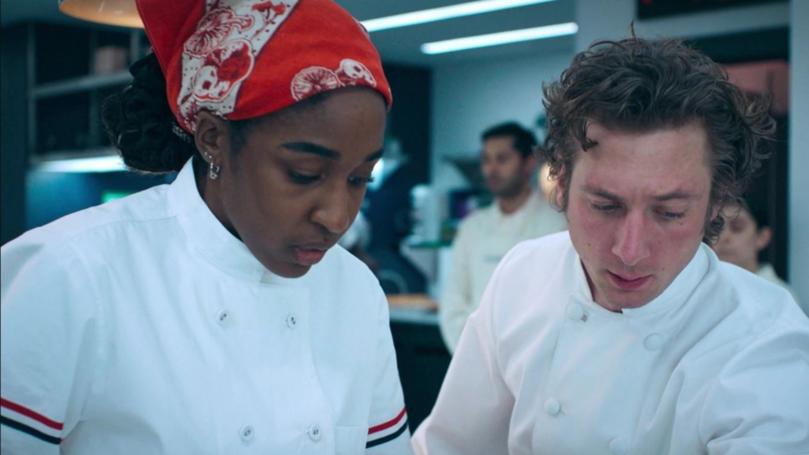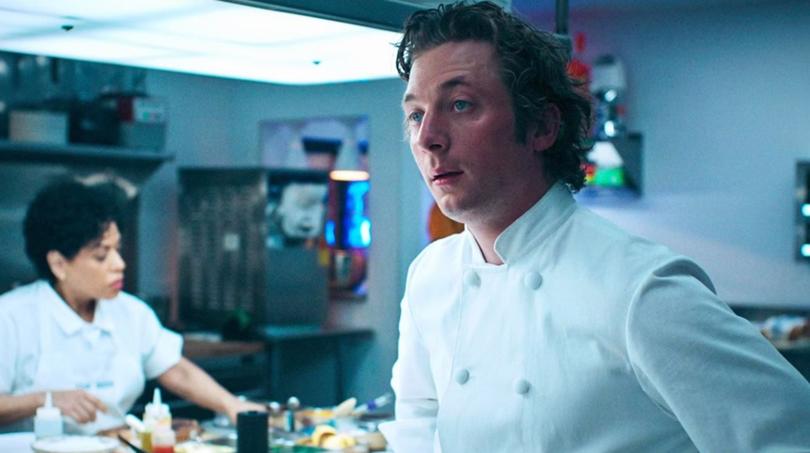THE NEW YORK TIMES: How would the restaurant in ‘The Bear’ work in real life?

SPOILER ALERT: This article discusses scenes from the beginning through the end of FX’s “The Bear Season 3, now available in full on Disney Plus.
When Season 3 of “The Bear” dropped last week, fans and food-world insiders got yet another chance to play restaurant-culture bingo. The incessant precision-snipping of green tape for the labeling of peas shelled during prep? Check. The “fancy, new earthenware” plates that the restaurant’s financial backer derided as he surveyed the allocation of his funds? Yes. The constant need for new C-fold towels? Always, Chef.
Devoted restaurantgoers recognized real chefs, real restaurants (Noma, Daniel, Ever, the French Laundry) and real “Orwellian butter” (a reference to Thomas Keller’s preferred Animal Farm Creamery butter, from Orwell, Vermont). Certain other details — the lack of influencers in the dining room, a menu of costly dishes that changes every day — seemed less realistic.
Sign up to The Nightly's newsletters.
Get the first look at the digital newspaper, curated daily stories and breaking headlines delivered to your inbox.
By continuing you agree to our Terms and Privacy Policy.We wondered: If the Bear were an actual restaurant, how would it truly run? We consulted hospitality experts, economists, chefs and longtime maitre d’s to help parse the touchstones that make the show feel so authentic, and to explain how the restaurant would operate as a true fine-dining destination in Chicago in pursuit of a Michelin star.
Daily Menu Overhauls (?!)
In Episode 2, Carmy Berzatto (played by Jeremy Allen White) declares, “We’re gonna get a star.” To get the attention of the Michelin judges, he decides the whole menu needs to change every day.
Curtis Duffy, chef and co-owner of Ever, where most of this season’s finale takes place, said a restaurant of the Bear’s caliber should actually take the opposite approach. “If Michelin is shopping you, it boils down to how consistent you can be with a meal over and over,” he said.
Not to mention that such a feat would be only marginally easier than running a full dinner service from inside a walk-in fridge. “On a scale of 1 to 10, 10 being most difficult, I would give changing the menu every day a 10,” said Aisha Ibrahim, executive chef at Canlis, in Seattle. “Consistency isn’t just the quality of the sauce on a dish, it’s also the information and how it’s relayed to the guest. If the chef is having a hard time remembering all the components, imagine the servers.”
PR Strategy, or Lack Thereof
Notably absent from the fictional restaurant’s opening weeks were the holy trinity of a modern hype-machine: influencers with ring lights chronicling caviar quenelles, a public relations team sending increasingly frantic dispatches about “buzz” and “rizz” to all the right food editors, and a press-preview dinner.
But Sue Chan said that in the case of the Bear, that might be OK. She is founder and chief creative officer of Care of Chan, an events and marketing company that puts on culinary gatherings (including for The New York Times Food Festival).
“I would actually advise Carmy not to get PR, because I don’t think he needs it; he has a known name and is respected — people are going to be naturally interested,” said Chan, who has more than 15 years of marketing experience, focused primarily on restaurants and chefs. According to her, there is a time and a place for paid buzz around restaurant openings, but it felt realistic that the Bear would skip it since it was hemorrhaging money, and retainers for such services can run $4,000 to $6,000 a month.
Chan said if she could handpick influencers and celebrities on Carmy’s behalf to dine at the Bear, she would trot out certain figures in phases to mirror “the different phases of a restaurant’s growth.” First, since the focus is a Michelin star, Chan says she would send in “as many of the big-name chefs as possible; if David Chang is coming in and posting about your restaurant, that’s a big stamp of approval, and if René Redzepi is coming in and posting, that’s a big stamp in a different way.”

Then, once Carmy is “jamming and wants to continue the buzz,” she would send “someone like chef Kwame Onwuachi,” because he has appeal to followers beyond just the culinary industry. Finally, she would invite “the Eric Wareheims of the world, because that gives you a certain cool cachet with more indie, hipster restaurantgoers.”
Indeed, the need for select restaurant PR might not wane after an opening season. Duffy noted that the series is so realistic that after Richie Jerimovich (played by Ebon Moss-Bachrach) staged at Ever in Season 2, diners would regularly come in and ask where he was. And (major spoiler incoming), since the finale for Season 3 revolves around the decision by Chef Terry (played by Olivia Colman) to shutter Ever, Duffy and his team discussed a PR push to ensure that diners didn’t think the real Ever had truly closed.
Paying the Bills
When midway through the season, Carmy’s sister Natalie (Sugar) Berzatto (played by Abby Elliott) explains why the restaurant needs to add another additional “turn” during dinner seating to make ends meet, it checks out. With a $175 per person prix fixe menu, 60 seats and 260 nights of service a year, she explains, each seat is worth $113,750 at 2 1/2 turns. (“Two-and-a-half turns” means that the restaurant is running a full service for all 60 seats twice, and for 30 of the seats a third time.) Duffy explained that the addition of a half-turn, rather than a full one, makes practical sense, since it often isn’t possible to squeeze in a full third turn when you consider staggered seating times and lingering guests.
But that half-turn can make a big difference.
“For a typical American restaurant, just 4 to 5 cents of a typical dollar is pretax profit,” said Hudson Riehle, senior vice president of research for the National Restaurant Association. “It has always been a notoriously thin operating margin.”
For the Bear, $113,750 per seat multiplied by 60 seats — before any revenue generated by liquor sales, which Riehle noted can be significant for high-end restaurants — means more than $6.8 million in gross revenue annually. At a 4% margin, the Bear team would see only $273,000 in annual profits.
At least rent doesn’t seem to be an issue for the Bear. It seems that Carmy’s brother left him the restaurant without a mortgage, but a listing for a ground floor retail space that’s roughly 2,800 square feet in Chicago’s River North neighborhood suggests that the rent would be more than $15,000 a month.
Stunts for Diners
Yet another cause for Carmy to roll his blue eyes is the parade of pinatas and Super Soakers through the kitchen on their way to diners’ tables, to surprise guests.
Arjav Ezekiel, who spent nearly a decade managing dining rooms at fine-dining restaurants before he opened Birdie’s in Austin, Texas, said these stunts are probably a reference to the “dreamweavers” that Eleven Madison Park had on staff, who were tasked with creating joyful, often personalized delights for guests — which tracks, since one of the many food-industry heavy hitters involved in this season was Will Guidara, a former partner at Eleven Madison.
“My reading of this season is that the way they operate their restaurant feels like they’re trying to get more than one star — that level of intensity is probably shooting for two or three,” Ezekiel said.
Toxic Kitchen Culture
As Chef David, Joel McHale brutally degrades Carmy during his days as a younger chef. Is that level of abuse accurate? Not quite as much these days, maybe.
“I think you could get away with it years ago, but you certainly couldn’t do it now. It was just the nature of the kitchen back then, chefs throwing things, people cussing and smoking,” Duffy said. “He wants him to be a better chef. Now, is that the best way to do that, by degrading him? Probably not.”
Ibrahim remembered her “first night on a fine-dining service was at a two Michelin-star restaurant in San Francisco, the chef de cuisine picked up a plate and threw it across the room and it shattered over my head.”
“I keep hearing whispers about this, people saying things have gotten better and shifted,” she added. “I still think there are restaurants out there that haven’t been called out.”
Disposable Plates
An orchestral clatter of crashes builds throughout the season as team members break those new earthenware plates. Eagle-eyed viewers will recognize the work of ceramist Jono Pandolfi, whose client list has a hefty overlap with the Michelin Guide. (Indeed, Guidara is a well-known buyer of Pandolfi’s wares for his restaurants.) In the show, Carmy has a meltdown when he thinks three of the bowls are of subtly different sizes. Pandolfi said the trio of bowls that Carmy has — to the tune of $26.50 each — are, in fact, identical.
Jeremy Levitt, founder of Parts and Labor Design, said a number of design elements within the refurbished space of the Bear seem correct for a fine-dining destination on a budget, such as the brick wall painted white. He cited the exposed ceiling joists, Scandinavian color scheme, clean lines and “pops of nature” such as the light wooden furniture, as key to “keeping the experience about the service, the food, the delivery.”
Levitt estimated that such a renovation would likely cost $1.2 million to $1.5 million, including the professional equipment such as a double Blodgett oven (which can be more than $50,000, depending on the model), and perhaps the only relatable tool for home cooks, a Vitamix (about $600 for a professional-grade model).
How Many Stars?
Much of Season 3 revolves around an impending review from the Chicago Tribune. When a photographer arrives for the Tribune shoot, he claims ignorance of what the critic plans to publish.
Colin Clark, a freelance photographer who has shot photos for Pete Wells’ New York Times restaurant reviews, said that rang true.
“All I know going in is that I need to cover certain dishes Pete wants to feature, plus the usual stuff like ambience/atmosphere, chef or owner portraits, exteriors,” said Clark, who has also shot photographs for reviews in New York magazine and Esquire, where he said the protocol is the same.
This article originally appeared in The New York Times.
© 2024 The New York Times Company
Originally published on The New York Times
